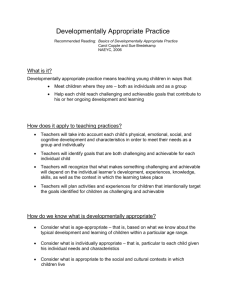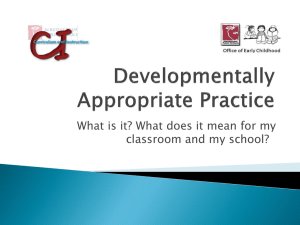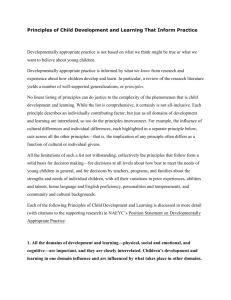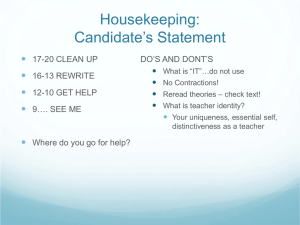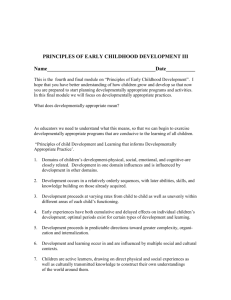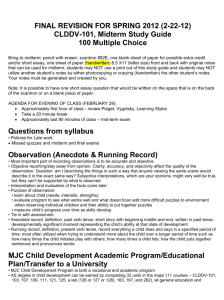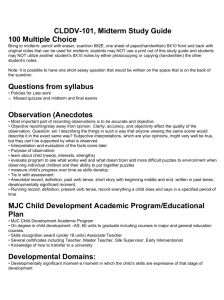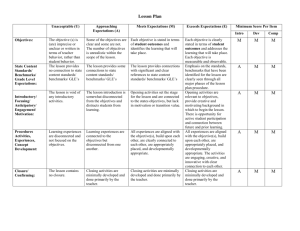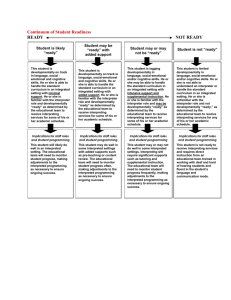Developmentally Appropriate Practice
advertisement
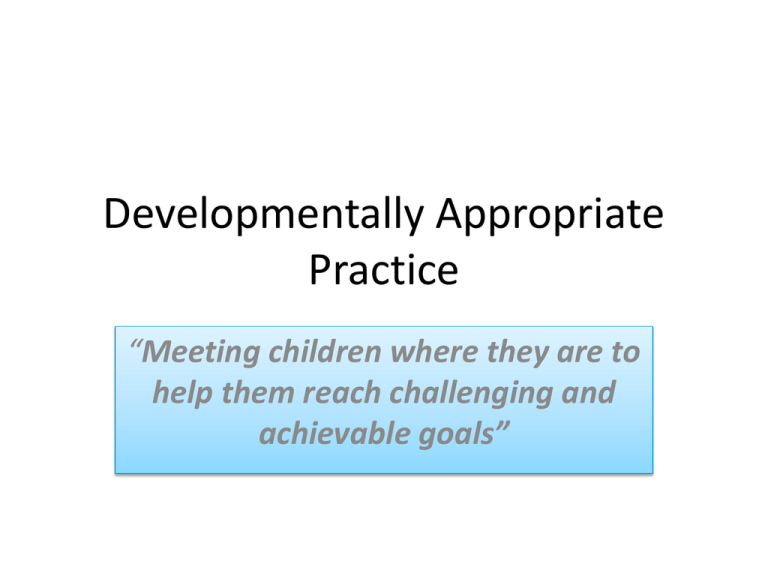
Developmentally Appropriate Practice “Meeting children where they are to help them reach challenging and achievable goals” Developmentally Appropriate Practice • D.A.P. simply stated is meeting children where they are, as individuals and as a group; and help each child reach challenging and achievable goals that contribute to his or her ongoing development and learning. D.A.P Meet learners where they are, taking into account their physical, emotional, social, and cognitive development and characteristics. D.A.P. Identify goals for children that are both challenging and achievable-a stretch, but not an impossible leap. D.A.P. Recognize that what makes something challenging and achievable will vary, depending on the individual learner’s development in all areas. Deciding what is developmentally appropriate. • It is important to remember that age matters. Children are not miniature adults. • Teachers must have a base-summary of common behaviors and abilities of children at a specific age. Intentionality • Teaching that meets learners where they are and helps them reach challenging and achievable goals does not happen by chance. Good teachers use purposeful and thoughtful actions and base their actions on the program outcomes. That is what goal is the program trying to help the child reach. D.A.P. • Good teachers recognize that each individual and group is different. • The averages and norms never tell the whole story. Think About… Consider what is age appropriate- Consider what is individually appropriate- • Ask yourself what do you know about the development and learning of children within a given age range. • Know each child in all of his or her individuality. Resources • Basics of Developmentally Appropriate Practice: An Introduction for Teachers of Children 3-6 Carol Copple and Sue Bredekamp Guidelines for Developmentally Appropriate Practice • • • • • Create a caring community of learners. Teach to enhance development and learning. Plan appropriate curriculum. Assess children’s development and learning. Develop reciprocal relationships with families. Community of Learners In a caring community of learners, everyone feels….. • I belong here. • I am safe. • I matter, and everyone else in the group matters too. • When we have problems we can work them out. • Together we can do great things. Physical Environment and Schedule • Ensure children’s health and safety. • Keep classrooms lively and “explorable”. • Take into account children’s interest and learning needs change over the course of the year. • Carefully plan daily routines. Guidance in a caring community… • How we interact with children shapes how they approach others, how they feel about themselves, and how they develop and learn. • Our expectations for children’s behavior affects them also. • Guiding children’s behavior begins with building a warm, positive relationship with them. Guidance: Self-regulation • Self-regulation is the ability to focus attention and manage one’s emotions and behaviors according to the demands of the situation. • Self-regulatory abilities gradually develop-or fail to develop-this can affect the interaction children have with people around them and influence their learning and school success. Test your guidance knowledge True or False Teachers are using effective guidance when they… • A) value mistakes as learning opportunities. • B) tell children to talk about their feelings and frustration at home. • C) resolve all conflicts, and don’t model for children the skills they need to solve problems on their own. • D) patiently remind children of rules and the rationales behind them. Strategies to be an effective teacher • Give positive attention that tells the child you noticed. • Offer comments or nonverbal actions that promote the child’s effort. • Offer specific feedback . • Show children a skill or desirable way of behaving. • Show the correct way to perform a procedure that needs to be done a certain way. • Generate a problem or difficulty to a task or step so that it is a bit beyond what children have already mastered. • Give a cue, hint, or other assistance. • Give children facts directly. Learning Formats • • • • Large Groups Small Groups Play/learning centers Routines Effective Curriculum • Good curriculum is much more than a collection of activities. • Curriculum should provide teachers with a useful framework for choosing learning experiences and materials and for seeing how those fit together to accomplish outcomes. Assessing Children’s Development and Learning Developmentally appropriate programs assess in order to… • Monitor children’s development and learning. • Guide our planning and decision making. • Identify children who might benefit from special services or supports. • Report and communicate with others. Family Relationships • In order to make developmentally appropriate decisions for children you must know them as individuals. • Families are the first teacher. They can provide needed information. • Teacher’s don’t have all the answers. Good relationships with families communicates respect and team effort. D.A.P. Quiz • Is D.A.P. a curriculum? • Does D.A.P. mean there is only one way to teach? • I teach children with disabilities. Won’t their learning suffer if I use D.A.P.? • Someone told me that in D.A.P. classrooms, all children do is play? Is this true? • Is it true that academics have no place in developmentally appropriate early childhood programs?
